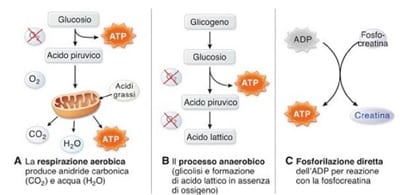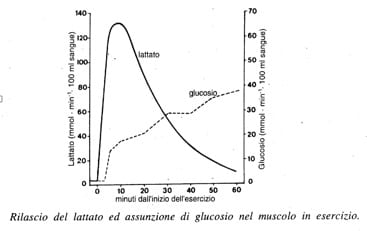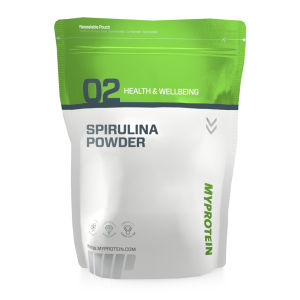By the healthiergang writer , graduated in Food Science and Technology, majoring in Nutrition and Functional Food.
Lactic acid in the muscles
Muscle fatigue, defined as the inability to maintain a certain intensity in the exercise or force generated over time, it is a phenomenon due to the onset of multiple biochemical events: decrease in metabolites such as glycogen and phosphagenes involved in muscle contraction and accumulation of metabolites that prevent contraction such as lactic acid and calcium.
Let's now focus on lactic acid. Lactic acid, (name IUPAC: 2-hydroxypropanoic acid) can be defined as a by-product of anaerobic metabolism, i.e. when the muscle is subjected to intense work and the aerobic metabolism is no longer able to meet the demands (lack of oxygen). However, lactate is produced throughout the day in conditions of rest, albeit in small quantities (about one hundred grams), by tissues that have an exclusively anaerobic metabolism (such as red blood cells) and by other tissues based on the availability of oxygen.
 Therefore, during medium / high intensity exercise (lack of oxygen), lactic acid begins to accumulate progressively in the muscles and blood. In fact, it is common, especially following an anaerobic physical training, to experience a state of muscle soreness and pain defined as Delayed Onset Muscle Soreness (DOMS). For the most part, muscle soreness is due to microtrauma and is defined as "delayed onset", ie not correlated with the production of lactic acid and perceived between 24 and 48 hours after anaerobic activity. the soreness perceived instead, during and immediately after anaerobic training with a sense of burning is defined as "rapid onset". This second type of transient soreness is directly related to excess lactic acid and is typical of anaerobic (lactacid) training, (1).
Therefore, during medium / high intensity exercise (lack of oxygen), lactic acid begins to accumulate progressively in the muscles and blood. In fact, it is common, especially following an anaerobic physical training, to experience a state of muscle soreness and pain defined as Delayed Onset Muscle Soreness (DOMS). For the most part, muscle soreness is due to microtrauma and is defined as "delayed onset", ie not correlated with the production of lactic acid and perceived between 24 and 48 hours after anaerobic activity. the soreness perceived instead, during and immediately after anaerobic training with a sense of burning is defined as "rapid onset". This second type of transient soreness is directly related to excess lactic acid and is typical of anaerobic (lactacid) training, (1).
Why is it formed?
To understand how lactic acid is produced in the muscles and how it contributes to muscle fatigue, it is necessary to briefly introduce some concepts. Muscle contraction requires energy. This can only be provided by an ATP molecule (adenosine triphosphate), a portion of this molecule is normally accumulated by the body but is sufficient to sustain just 1-2 seconds of contraction. Therefore, the ATP must be constantly regenerated. This happens in three different ways: through the aerobic process (with oxygen), via direct phosphorylation or through the anaerobic process (absence of oxygen).
Direct phosphorylation moves through three main steps: first the muscle cell uses the ATP reserves to contract, once exhausted it will regenerate them with the fastest mechanism (direct phosphorylation) through the mobilization of phosphocreatine (creatine phosphate CP) able to donate a phosphate group in ADP "re-transforming" it into ATP making it possible to contract and relax the muscle.
Anaerobic cellular respiration occurs after direct phosphorylation, when the oxygen in the muscle cells has been used for other metabolic processes, the body enters a state of "oxygen debt". In this situation, a glucose molecule is "broken" through the glycolytic pathway to produce ATP and allow the muscle to contract and relax but, due to the absence of oxygen, the metabolic pathway will not be complete (oxidative phosphorylation) and will have a lower efficiency in terms of ATP production. In fact, only two molecules of ATP will be produced for one molecule of glucose out of the 36 resulting from the complete oxidation of glucose.
Furthermore, the only way that the muscle cell has to follow this metabolic pathway is the reduction of pyruvic acid (the last derivative of glucose) to lactic acid, with subsequent accumulation of the same. Lactic acid is therefore released into the muscles when they have exhausted the normal energy reserves (ATP) but there is still a need for energy. The lactate before being accumulated can act as a temporary energy reserve through the conversion into glucose by the liver, on the other hand if the anaerobic effort is prolonged this mechanism will not be able to meet the energy demands and the result will be an inevitable sensation. of burning in the muscles with subsequent decline in athletic performance (2).
 Therefore the production and, in particular, the accumulation of lactic acid proceeds in several steps, at first there is a depletion of muscle energy reserves (direct phosphorylation) which lead to the activation of the anaerobic system for energy production, at this point the production of lactic acid begins but the body is able (in normal physiological conditions) to “dispose of it” and indeed, to use it in a functional way (conversion into glucose by the liver). The problem for the athlete arises when the synthesis speed will be greater than that of disposal, at this point, muscle fatigue will arise, leading to the progressive decay of physical performance with the inability to contract and decontract the muscle culminating in phenomena known as muscle cramps.
Therefore the production and, in particular, the accumulation of lactic acid proceeds in several steps, at first there is a depletion of muscle energy reserves (direct phosphorylation) which lead to the activation of the anaerobic system for energy production, at this point the production of lactic acid begins but the body is able (in normal physiological conditions) to “dispose of it” and indeed, to use it in a functional way (conversion into glucose by the liver). The problem for the athlete arises when the synthesis speed will be greater than that of disposal, at this point, muscle fatigue will arise, leading to the progressive decay of physical performance with the inability to contract and decontract the muscle culminating in phenomena known as muscle cramps.
It is therefore incorrect to correlate lactic acid with muscle aches and pains, since these are actually caused by the so-called DOMS (micro tears of muscle tissue) that cause a painful state. The presence in high concentration in the muscle of lactic acid it is simply a signal that the aerobic limits of metabolism have been reached (burning). What causes the exhaustion of performance is not lactic acid as such, but the inefficiency of the anaerobic metabolism that leads to its formation, which, as mentioned, has a much lower capacity than that of aerobic energy metabolism. This explains why anaerobic performance is so short, and the significance of anaerobic glycolysis is precisely to support energy metabolism during short and very high intensity efforts (such as shots and progressions).
How to dispose of lactic acid? Remedies
To stem these phenomena, an athlete can try to prevent and / or limit their accumulation in different ways. Nutrition and integration are undoubtedly at the forefront of the athlete however, it must be premised that the ability to resist the production of high concentrations of lactic acid in the muscles depends for the most part on training. For this reason, specific training methods have been developed that allow to improve the so-called "Resistance to lactate". The possible role of nutrition and supplementation in contrasting lactate (which is chemically an acid) is based on the antacid (ie alkalizing) action of foods and supplements.
One of the most important precautions is undoubtedly to maintain good body hydration, lactic acid is soluble in water, so the more hydrated the muscle tissues, the greater the dispersion and transmission in the blood flow of the same. Alkalizing substances such as bicarbonate or calcium carbonate can be used as "buffer" substances (doses of 3 g / d are suggested). For the same purpose un another alternative carnosine (1 g / d) or magnesium which can be introduced through hydrosaline drinks or simply by increasing the consumption of foods such as green leafy vegetables, legumes and whole grains. However, it should be remembered that the effect of these substances can be compared to that of painkillers that is, it would be like trying to "suffocate" a message that our body is sending us (possibility of incurring serious muscle injuries).
 Some studies (3) show how a supplement based on spirulina (spirulina platensis) is correlated with a lower development of DOMS and oxidative stress but above all how the activity of a key enzyme for the disposal of lactic acid (lactate dehydrogenase LDH) is increased. This correlation seems to be due to the composition of spirulina itself, an alga containing all the amino acids and essential fatty acids but above all with a high vitamin content (B1, B2, B3, B6, folic acid, vitamin C, vitamin D, vitamin A and vitamin E), pigments (beta-carotene, zeaxanthin, chlorophyll-a, xanthophyll, etc ...) and trace elements (potassium, calcium, chromium, copper, iron, magnesium, manganese, phosphorus, selenium, sodium and zinc). These latter components appear to affect the rate of lactic acid disposal and to act as a protection for the muscle during exercise (4)).
Some studies (3) show how a supplement based on spirulina (spirulina platensis) is correlated with a lower development of DOMS and oxidative stress but above all how the activity of a key enzyme for the disposal of lactic acid (lactate dehydrogenase LDH) is increased. This correlation seems to be due to the composition of spirulina itself, an alga containing all the amino acids and essential fatty acids but above all with a high vitamin content (B1, B2, B3, B6, folic acid, vitamin C, vitamin D, vitamin A and vitamin E), pigments (beta-carotene, zeaxanthin, chlorophyll-a, xanthophyll, etc ...) and trace elements (potassium, calcium, chromium, copper, iron, magnesium, manganese, phosphorus, selenium, sodium and zinc). These latter components appear to affect the rate of lactic acid disposal and to act as a protection for the muscle during exercise (4)).
Conclusion
In summary, it is now ascertained how lactic acid is not the main cause of muscle fatigue and pain following a high intensity physical performance but, rather, as an accumulation of the same it affects phenomena such as localized muscle burning, which can be interpreted as a signal that our body sends us to warn us that it is no longer able to meet the energy demands. Nutrition and supplementation can intervene marginally to help the body, especially in its disposal, while the most effective solution to increase resistance to lactate accumulation are specific training programs.


























